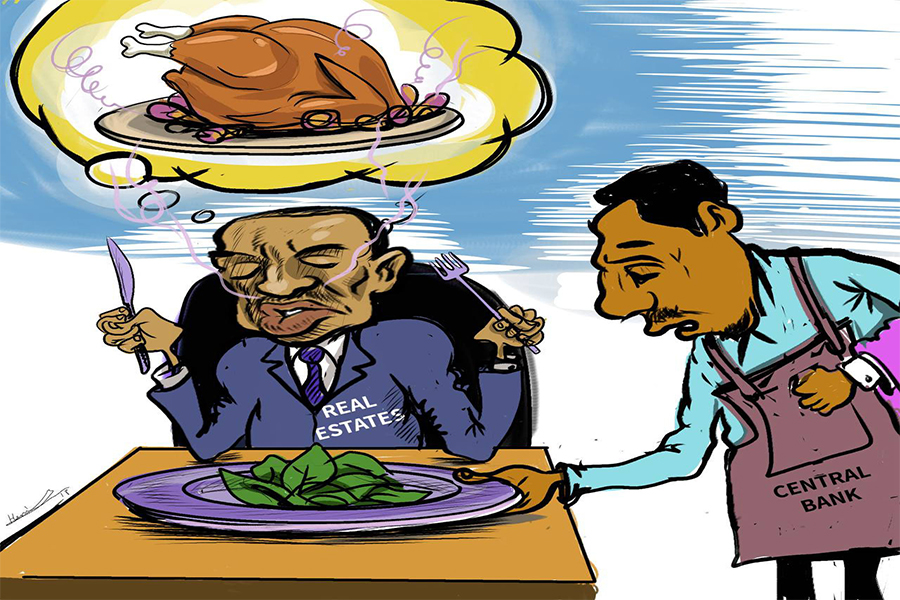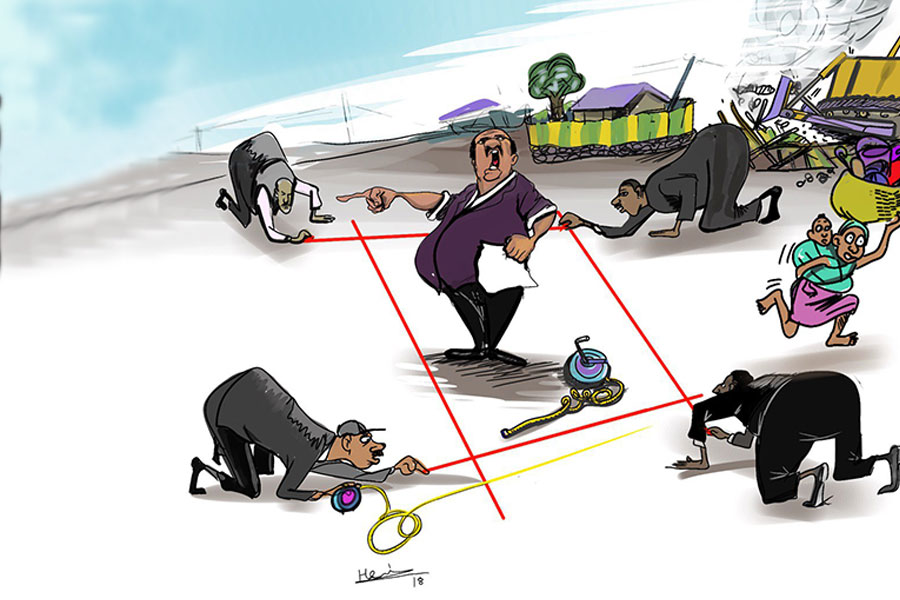
Bunna Bank, in its 15th year of operation, has posted noteworthy gains in deposits and total assets in the 2023/24 financial year while revealing mounting challenges in profitability, an outcome that illustrated the increasingly competitive and inflation-affected banking industry.
The Bank’s total assets climbed by 17.5pc to 54.53 billion Br, and deposits rose by 20pc to 43.87 billion Br. Analysts praised these advances as signs that Bunna Bank was effectively expanding its market presence. Yet, its profit before tax fell, uncovering the difficulties in sustaining margins when funding costs rise and broader macroeconomic fluctuations persist.
Earnings per share (EPS) painted a less rosy picture, too. They have dropped over the past three years, going from 341.22 Br in 2022 to 238.44 Br in 2023 and then down to 161.57 Br last year.
“This should be worrying,” said Aminu Nuru, a financial analyst based in Doha, Qatar.
He believes consistent declines in EPS are signals that the Bank’s profitability issues could persist.
However, not all shareholders seem troubled by the downward trend. A founding shareholder, Tesfaye Fente, believes the focus should be on the Bank’s sustainability rather than share earnings.
“It’s a Bank with strong potential, lower staff turnover, and stable management,” Tesfaye told Fortune. "When reserves are held, and investments are made, short-term pressures on profitability might not necessarily harm the institution over the long run."
He attributed some of his optimism to the stability of the Bank’s management team.
Since Bunna Bank was incorporated 14 years ago with 175 million Br in paid-up capital raised from around 8,000 shareholders, Mulugeta Alemayehu, president of the Bank, has become only its fourth president. His tenure began in 2018, after a stint at the state-owned Commercial Bank of Ethiopia (CBE), and he has since overseen Bunna’s capital growth and strategic decisions.
Under Mulugeta's stewardship, who graduated from Addis Abeba University in accounting and business administration and previously served CBE as a vice president, Bunna’s paid-up capital grew by 12.8pc to 4.8 billion Br last year alone. The Capital Adequacy Ratio (CAR) for the same period was 14.44pc, exceeding the regulatory requirement.
However, the strain on profitability emerged in the Bank’s returns on assets. Bunna Bank’s net profit of 730.4 million Br translated into a return on total assets of a mere 1.34pc, showing that while the balance sheet has grown, the conversion of these assets into earnings has not kept pace. Compounding this pressure is the Bank’s heavy reliance on interest income, which accounted for 84.6pc of total earnings, leaving Bunna Bank particularly exposed to the rising deposit expenses that made up 40.6pc of its total operating costs.
The surge in fixed-time deposits, which saw interest on such accounts rise sharply, has been a major driver of these higher funding expenses. Fixed-time deposits more than doubled, going from 2.07 billion Br to 4.25 billion Br, driving interest expenses on these deposits up to 793 million Br.
Bunna Bank’s senior executives acknowledge these pressures.
“Some expenses are permanent,” said Mulugeta, referring to staff salary adjustments and other recurring costs. “And human capital is an asset.”
Consistent with trends in the wider industry, wages and benefits for employees steadily climbed. Nearly half of its operating expenses were dedicated to personnel and administrative costs, substantial investments in human capital and operational support. While this rise reflected a commitment to retaining talent, it also squeezed margins. The Bank’s total operating income grew by 8.3pc to 5.15 billion Br from the previous year, but this did not prevent a 31.6pc drop in gross profit to 930 million Br. Net profit, too, slipped by 23pc to 730.4 million Br during the same period.
Mulugeta attributed the pressure on interest income to the credit growth cap Central Bank regulators imposed on the industry.
Given that interest income made up 84.6pc of total income, any constraint on lending directly affects the Bank’s earnings power. Though its revenue rose 20pc from the previous fiscal year to reach 8.03 billion Br, the interplay of higher deposit costs, regulatory credit growth restrictions, and personnel expenses has cut deeply into the bottom line. Mulugeta conceded that the annual pay increases for staff have a lasting impact on the Bank’s cost structure.
While Bunna Bank has been relatively measured in branch expansion — adding 2.8pc more branches to 474 and expanding its permanent workforce by 72 employees (a 1.8pc rise) to 4,172 — the incremental costs still proved substantial in an environment of rising operating expenses.
“We’ve consolidated some branches for efficiency,” Mulugeta said, echoing the focus on rethinking the Bank’s branch-centric approach and streamlining operations.
However, the Bank generated considerable returns on its human capital, serving as a critical benchmark for assessing workforce productivity, yielding an average of 175,000 Br. Total deposits mobilised by an average branch reached 92.5 million Br.
Zena Assefa, a branch manager at Bunna Bank’s headquarters on Africa Avenue (Bole Road), observed that the liquidity crunch, coupled with shifting policy mandates, were a challenge last year. Yet, he maintained that his branch surpassed foreign exchange generation and deposit mobilisation targets.
“The proximity to the headquarters and its location has made our branch convenient for corporate customers,” Zena told Fortune.
According to Zena, partnering with fintech firms is a key objective in the new fiscal year, and he expects the Bank’s digital transformation strategy to propel further growth. Mulugeta reinforced this view, crediting ongoing partnerships with fintech companies such as Kifiya, Kacha, and Telebirr with accelerating digital transformation.
“Local partnership is vital to solve corporate issues,” he told Fortune.
Mulugeta and his senior executives' approach to credit risk management has so far been successful. The non-performing loan (NPL) ratio was at 3.84pc, below the five percent regulatory threshold set by the National Bank of Ethiopia (NBE). With loans and advances of 38.87 billion Br, the Bank strongly focused on lending. Still, its overall leverage was high, indicated by an asset-to-equity ratio of 7.72, which boosted any potential earnings downturn if asset quality weakened.
Bunna Bank’s capital-to-asset ratio of around 13pc remained comfortably above the minimum standards required by regulators, though it was not as high as some of its peers.
Bunna Bank remains a relatively smaller player when measured against major financial institutions. The state-owned Commercial Bank of Ethiopia (CBE) reported asset growth of nearly 48pc and boasted a massive deposit share that dwarfs Bunna’s. Awash Bank, another leading private bank, maintained a wider retail and corporate reach, translating into stronger deposit mobilisation. Dashen Bank and the Bank of Abyssinia, among the larger private banks, pursued more aggressive lending strategies and have broader footprints, enabling them to generate higher lending volumes and foreign exchange business.
Bunna Bank, by contrast, has adopted a more conservative posture in its foreign currency operations, mirroring its narrower capital base and smaller branch network.
Its loan-to-deposit ratio has drawn attention to its potential risk implications. At 102.8pc — loans of 38.1 billion Br against 37.1 billion Birr in deposits — the ratio raised the eyebrows of industry analysts. Such a high ratio can constrain a Bank’s ability to meet withdrawal demands and force it to tap costlier borrowing sources.
“This ratio is a crude indicator,” said Mulugeta. "If the deposit structure is stable, the ratio may not be as alarming as it appears."
According to the President, three-quarters of the total deposits are savings accounts, and historically, this has shown steady behaviour.
However, Aminu cautioned that relying on more expensive funding avenues and the possibility of liquidity bottlenecks cannot be ignored.
Bunna Bank’s loan book was heavily concentrated in international trade, with about 41.5pc allocated to import and export financing. The remaining portfolio was spread across domestic trade and services (18pc), building and construction (12.1pc), industry (7.1pc), and other sectors (21.3pc). According to Aminu, the Bank's dependence on global trade could expose it to volatility from currency fluctuations and shifts in international demand.
Mulugeta acknowledged the importance of diversification but voiced confidence that his team’s case-by-case management approach to clients would keep credit quality in check.
“We’re looking into it,” he told Fortune.
The Bank's Board Chairman, Alemayehu Sewagegn, guided it toward a five-year strategic plan focused on digital, human resources, and information technology. Shareholders were told that these plans would include policies targeting customer protection. Mulugeta backed this vision. He believes Bunna Bank’s tagline — “Bank of Visionaries” — stands for a service approach that is both customer-centric and value-based.
PUBLISHED ON
Feb 23, 2025 [ VOL
25 , NO
1295]

Dec 22 , 2024 . By TIZITA SHEWAFERAW
Charged with transforming colossal state-owned enterprises into modern and competitiv...

Aug 18 , 2024 . By AKSAH ITALO
Although predictable Yonas Zerihun's job in the ride-hailing service is not immune to...

Jul 28 , 2024 . By TIZITA SHEWAFERAW
Unhabitual, perhaps too many, Samuel Gebreyohannes, 38, used to occasionally enjoy a couple of beers at breakfast. However, he recently swit...

Jul 13 , 2024 . By AKSAH ITALO
Investors who rely on tractors, trucks, and field vehicles for commuting, transporting commodities, and f...

Oct 11 , 2025
Ladislas Farago, a roving Associated Press (AP) correspondent, arrived in Ethiopia in...

Oct 4 , 2025
Eyob Tekalegn (PhD) had been in the Governor's chair for only weeks when, on Septembe...

Sep 27 , 2025
Four years into an experiment with “shock therapy” in education, the national moo...

Sep 20 , 2025
Getachew Reda's return to the national stage was always going to stir attention. Once...